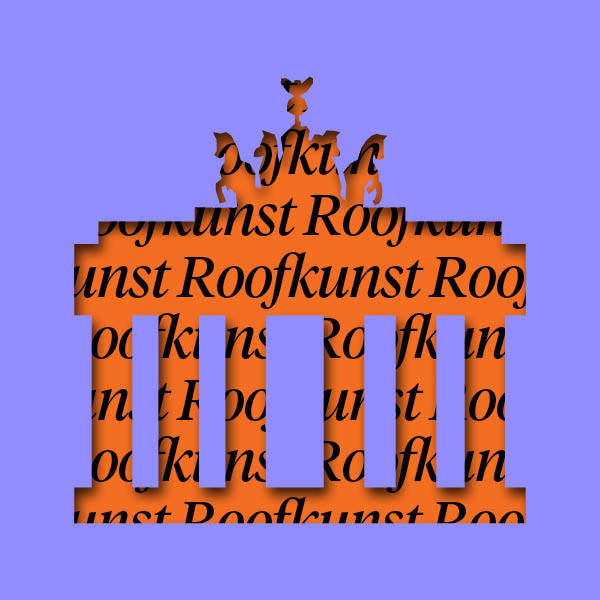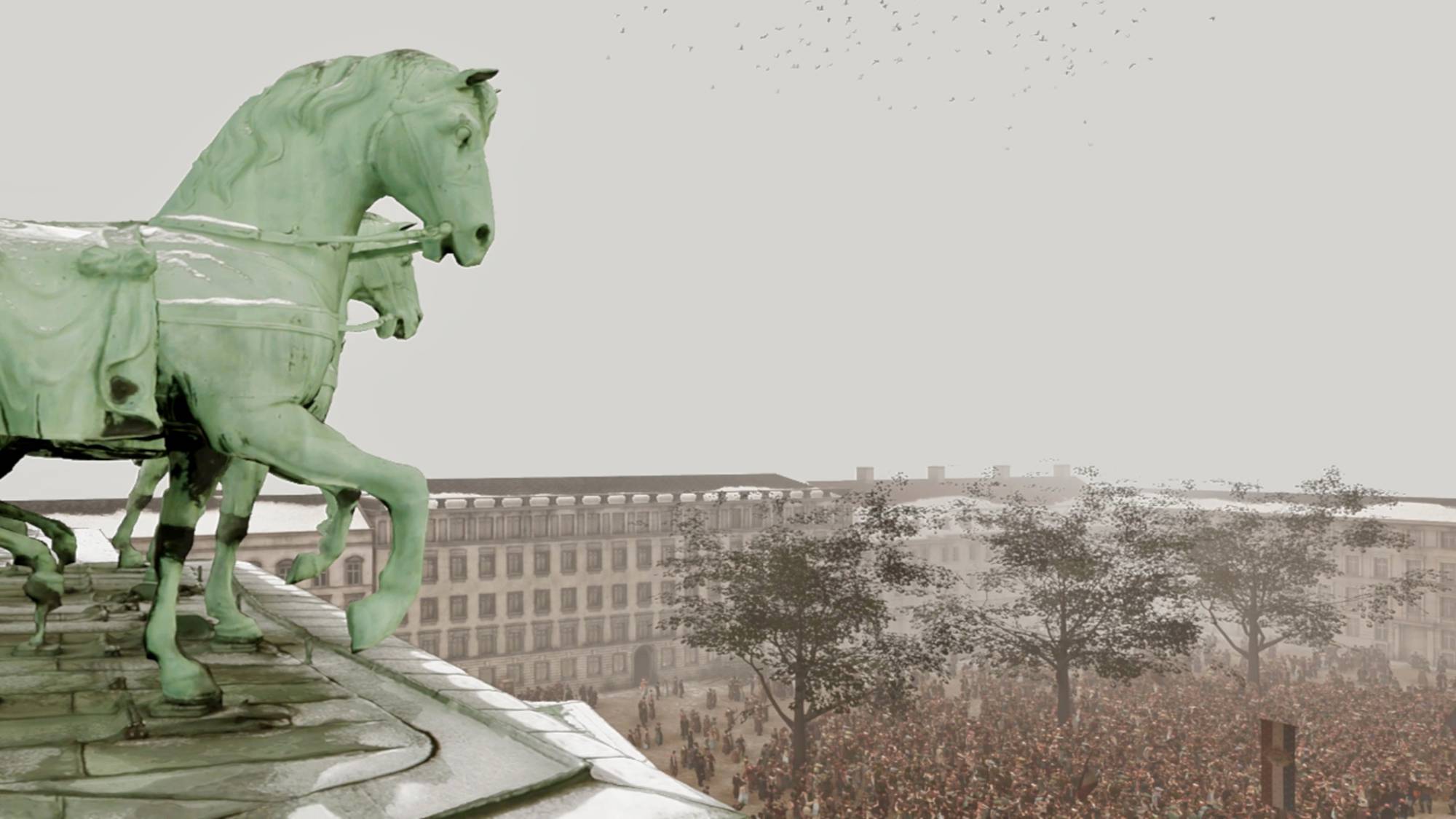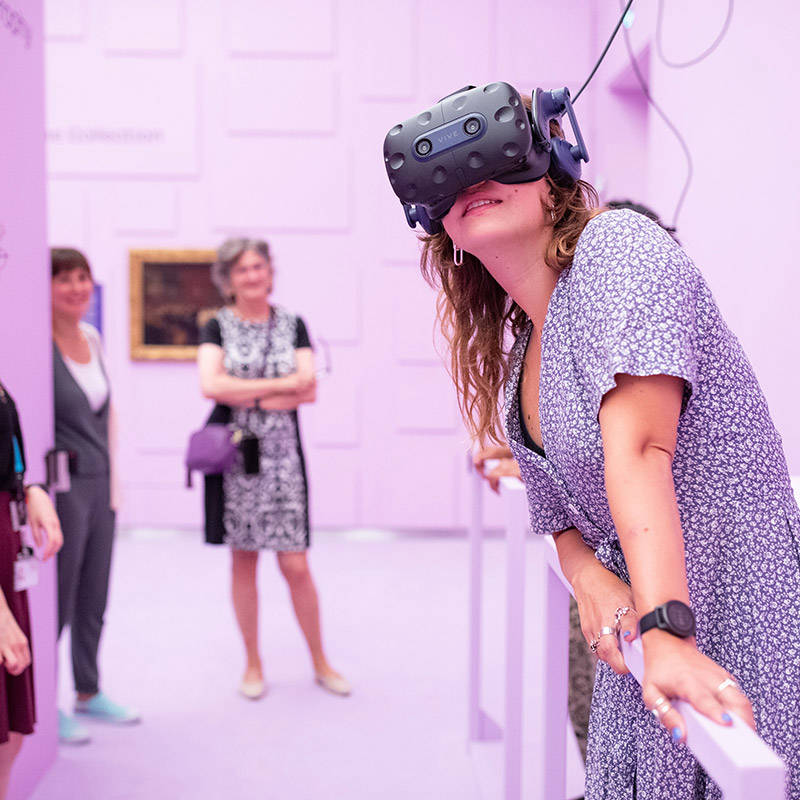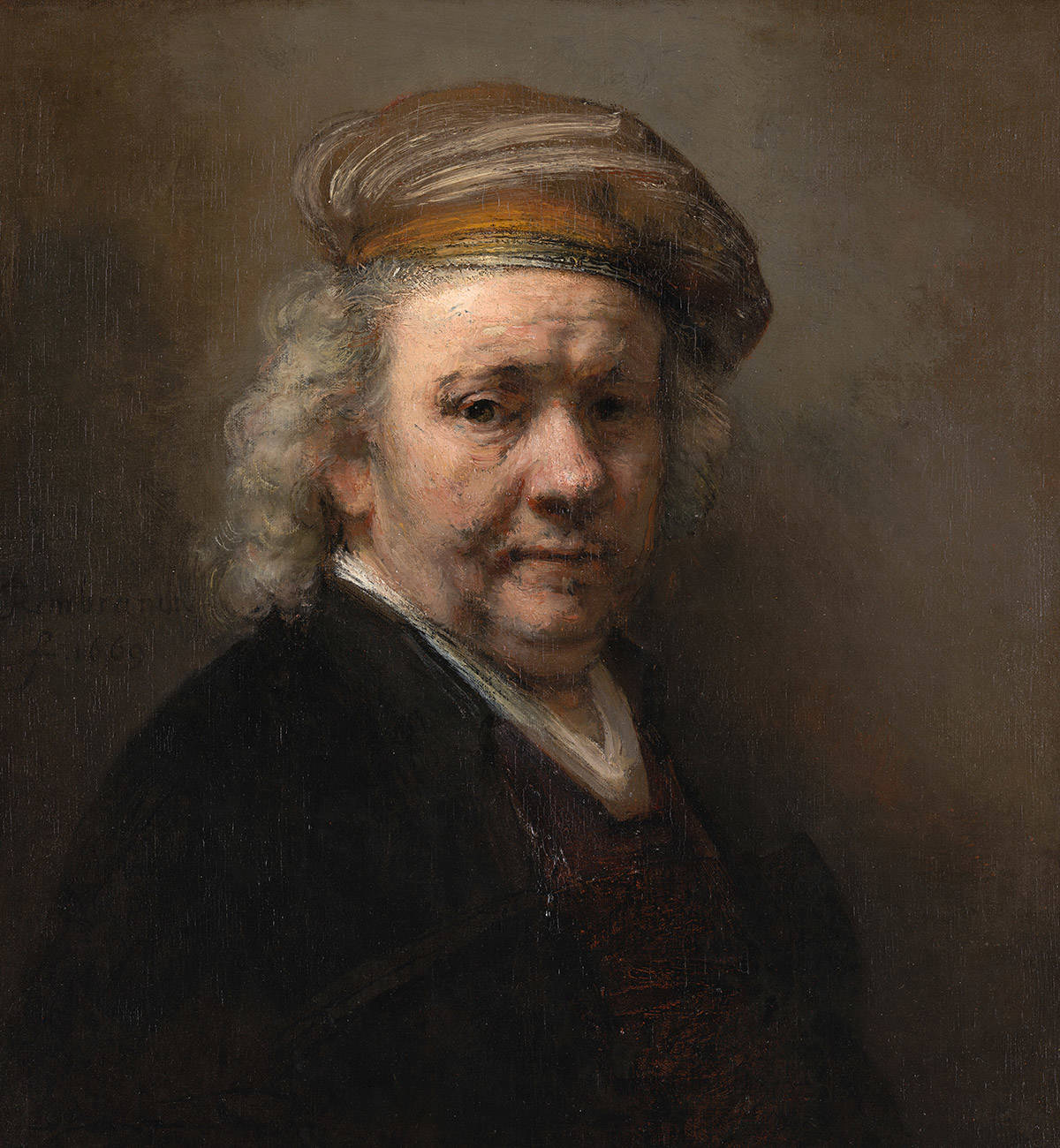Loot - 10 stories
Jongsma + O’Neill x Mauritshuis

14 September 2023 - 7 January 2024
Suppose you are the director of a museum that houses art that was once stolen. How do you deal with it? Should you return it? Do you leave it there? And if you leave it there, are you as a museum complicit in looting?
The exhibition Loot - 10 stories shares the struggle museums have with stolen art. Where did the looted objects come from? Why were they stolen? With a VR headset on, you suddenly find yourself in a secret art storage. In a tunnel, a kilometre underground, you're all of a sudden eye-to-eye with a stolen Rembrandt. How did it end up there?
Please note: Due to the limited capacity of the unique VR experiences within the exhibition, it is necessary to book a ticket online in advance.
A virtual journey through history
Loot - 10 stories shows stolen objects from three periods: art looted by French revolutionaries in 1795, art taken from Jewish owners by Nazis and colonial looted art. Using virtual reality, you will discover the history of these objects. Artist duo Jongsma + O'Neill use video installations and digital techniques to show the influence of this history today. What would happen if all the objects were returned to their rightful owners?

Practical information
Parts of this exhibition can only be viewed with a VR headset. We'll assist you with that. As you need the space to experience the exhibition, reserving a time slot is mandatory.
Can we tour the exhibition with a group?
Unfortunately that is not possible, as the exhibition is designed for individual visitors. You can book tours of our permanent collection here.
Why do I need to visit the temporary exhibition first?
Loot - 10 stories has a limited capacity, due to the use of VR. By visiting the temporary exhibition first, you help us optimize the visitor experience for everyone.
How much time does it take to visit the exhibition?
We estimate that a visit takes around 40 minutes.
Do I need to book a timeslot in advance?
Due to the limited capacity of the exhibition, it is required to book a timeslot online in advance. We don't sell tickets to this exhibition at the counter.
If I'm late, can I still enter the exhibition?
To manage crowds, we have to be a little bit strict in regards to the timed tickets. If you are somehow delayed, please consider rebooking your tickets through the support button in our online ticket shop.
I have a ticket but can't make it to the museum. Can I rebook?
As long as tickets are available, it is possible to rebook the tickets through the support button in our ticket shop. Refunds are unfortunately not possible.
Trailer

Loot - 10 stories
Watch the trailer.
What is looted art?
The answer to that question is simple and complicated at the same time. Looted art refers to art or objects that somehow unlawfully ended up in museums. Objects that were stolen in colonial times or during wars, confiscated or forcibly sold, exchanged or ceded.
Much of this art ended up in museums in the nineteenth, early twentieth century, when museums emerged in Europe. For these museums, tracing the original owners is complicated. There are no receipts with the objects. Some objects were looted centuries ago. It often takes a lot of research to trace the provenance of an object.
Who is the owner of Rembrandt's Self-Portrait?
The provenance of Rembrandt's Self-Portrait from 1669 has been ascertained. It's now property of the Dutch state. That applies to all the paintings in our museum, by the way. State museums don't own the art they exhibit, they only manage it. But in 1940, the Rembrandt belonged to the Jewish Rathenau family. Until the Nazis confiscated it during World War II. They wanted to display the painting in Adolf Hitler's (never realised) Führermuseum.
After liberation, the self-portrait was found in the salt mines of Altaussee in Austria. There, the Nazis collected their looted art; a huge amount of paintings and objects. Fortunately, the Rembrandt could be returned to the Rathenau family after World War II. In 1947, the Dutch state bought it from the family. It's been in our museum ever since.

Objects in the exhibition
FAQ
Why does the Mauritshuis stage the exhibition Loot-10 stories?
The subject of looted art has become very topical in recent years. Until the end of the 20th century it was quite common for European museums to display or store in their repositories objects from former colonies. In recent years, these objects have become the subject of debate. Should they be returned to their countries of origin? If so, how and when? All at once, or in batches? Who should they be returned to: the state, individual heirs, the region from which they were taken? How important is provenance research and collaboration with experts from countries of origin? How does looted colonial art relate to other forms of looted art, such as that stolen by Napoleon, or the Nazis? Are there parallels, or are these all cases apart?
Martine Gosselink, director of the Mauritshuis, came up with the idea of having curators work together to highlight questions like this that are associated with looted art. Though the exhibition might not have an oven-ready answer to these questions, it will hopefully prompt debate and discussion. The key question is: what is the future for looted art that is now shown or stored in repositories at museums all over the world (and especially in Europe)?
What does the Mauritshuis hope to achieve with the exhibition Loot - 10 stories?
Both the design and the storytelling are essential to the underlying idea of the exhibition, which is to give visitors a glimpse of the difficult history of museum objects, and of a possible future for looted art and restitution. The Mauritshuis and guest curators Jongsma+O’Neill explore how the museum of the future might look after part of the collection is returned. The exhibition also considers objects that in all probability cannot be returned, because their history can never be fully traced, or no legitimate owners can be found.
In this context, it is important to consider who decides whether replicas may be made of original looted artefacts. Should the reproduction rights also be transferred when looted objects are restituted? Should museums continue to display, study and duplicate original items – or replicas – in the future and if so, how?
Above all, however, the Mauritshuis hopes to demonstrate in this exhibition how complex the reality of looted art is. Each case is unique. There is no one-size-fits-all solution. Every object has its own story, and deserves its own investigation and its own future. Every object was once made for a specific purpose, in a specific place. When it was stolen, it was ripped out of its context, and later became a museum object, isolated from everything and everyone it was once part of. Restitution is just a small step towards correcting historical injustices. But by carefully considering, together with all stakeholders, how we can return stolen items to their original owners, we can start to put things right.
I would like to share my thoughts or feedback regarding this exhibition.
Please send a message to mail@mauritshuis.nl. We'll forward your message to the appropriate colleagues.
What is the Mauritshuis’s interest in this subject?
The subjects of colonialism and slavery (inextricably linked with the subject of looted art) are intricately interwoven with the history of the Mauritshuis, which was built by Johan Maurits van Nassau-Siegen, governor of the colony of Dutch Brazil, who also traded enslaved people. When he returned to The Hague after holding the post of governor for eight years (1636-1644), he brought with him countless objects – with or without the permission of the original owners. They included militaria, jewellery, ceremonial objects, and also people and animals. We know for certain that of none of those original objects are at the Mauritshuis today, as the entire building (apart from its outer walls) was destroyed by fire in 1704.
Until 1875 the first floor of the Mauritshuis (which became a museum in 1822) housed the Royal Cabinet of Curiosities, where items including colonial objects like the cannon of Kandy were displayed. They were however removed from the museum in 1875 and distributed among several other museums, including the Hague Historical Museum and the Rijksmuseum. This summer, it was announced that the Dutch State is to return the cannon of Kandy to Sri Lanka, where it was stolen in 1765.
In 1795 French revolutionary soldiers stole Prince Willem V’s entire collection when they occupied the Netherlands (1795-1813). The paintings went to the Louvre, which for a number of years housed the Musée Napoleon. After the fall of Napoleon a large proportion of the looted paintings were returned to the Netherlands, where they were hung in the recently opened Mauritshuis in 1822.
Finally, the Mauritshuis has in its care 25 paintings from the NK collection of items looted, confiscated or purchased by the Nazi regime and returned to the Netherlands from Germany after the Second World War and handed over to the care of the Dutch State. A number of other paintings purchased by the Mauritshuis after 1945 were stolen from their original owners during the war. In recent decades, requests for the return of such items have been considered, and objects have been returned to the heirs of the rightful owners. Loot includes a painting (Rembrandt, Late Self-Portrait, 1669) that was stolen by the Nazis, later returned to the original Jewish owners and then bought by the Mauritshuis in 1947. For more information on the NK collection go to: https://www.collectienederland.nl/vc/nk/
Does the Mauritshuis itself have looted colonial art in its collection?
The Mauritshuis no longer has any looted colonial art because since the items from the Royal Cabinet of Curiosities were moved in 1875, it has only shown paintings, none of which has colonial origins. The paintings by Frans Post and Albert Eckhout were added to the collection later.
Were there colonial objects at the Mauritshuis when Johan Maurits lived there?
Yes, there were lots of objects that Johan Maurits had brought with him from Brazil. There was a lot of tropical hardwood in the building, and the walls featured frescoes of Brazilian landscapes and other scenes. The grand hall on the upper floor was full of art and objects from Brazil, including headdresses, gemstones, feathers, shells, spears and stuffed animals. There may also have been paintings of Brazilian landscapes and flora and fauna that Johan Maurits commissioned from Albert Eeckhout and Frans Post.
What happened to the paintings that were stolen in 1795?
They went to the Louvre and most were returned to the Netherlands after the fall of Napoleon in 1815. Not all of them though. Around 67 paintings had already been distributed to other French museums, and they are still there to this day. The paintings that were returned formed the basis of the Mauritshuis collection when it opened as a museum in 1822.
What does the museum visitor see in the exhibition Loot-10 stories?
Visitors to the exhibition will encounter three assemblages of objects, three virtual reality experiences and three video installations. The presentation methods in Loot will underline the aim of making the controversial histories of these museum objects clearly visible to the public. The exhibition design by Trapped in Suburbia will take visitors to another world, a world that resembles a museum depot.
Who are the guest curators Eline Jongsma and Kel O’Neill and what did they do for this exhibition?
Creative duo Eline Jongsma and Kel O’Neill (NL-US) use innovative storytelling methods to explore history’s impact on contemporary society. Their Emmy-nominated, Webby-honored immersive works and documentaries screen at world-renowned venues including Tribeca, SXSW, The New York Film Festival, and Rencontres d’Arles. They’ve received fellowships from the Sundance Institute, the Eisenhower Fellowships and the Economist Media Lab, and won the Tim Hetherington Visionary Award and the IDFA DocLab Special Jury Award for Creative Technology.
Eline Jongsma and Kel O’Neill of Jongsma + O’Neill were invited to join the project at an early stage as creative leads and guest curators, to develop the framing and storytelling in collaboration with other curators and researchers. The artistic and filmmaking duo have more than ten years’ experience with non-fiction projects, including films, interactive documentaries and VR experiences. Jongsma + O’Neill will use highly innovative methods of presentation in the exhibition to tell the stories of the objects. This will include virtual reality experiences and 3D models, which will prompt visitors to think about the questions that lie at the centre of the exhibition. How and why were these objects looted? How do we respond to this as a museum? What, ideally, should be the future of these objects?
What is the Humboldt Forum and why does the Mauritshuis cooperate with this museum?
The Humboldt Forum is Berlin has a very large collection of colonial objects, the Mauritshuis got in touch with this museum and asked if they wanted to collaborate with us. The exhibition will be shown at the Humboldt Forum after the Mauritshuis.
The Humboldt Forum, which opened to the public in 2021, is a collaboration between the Stiftung Humboldt Forum im Berliner Schloss; the Stiftung Preussischer Kulturbesitz for collections from the Ethnologisches Museum and the Museum für Asiatische Kunst of the Staatliche Museen zu Berlin; the Humboldt-Universität zu Berlin for the Humboldt Labor; and the Stadtmuseum Berlin for the BERLIN GLOBAL exhibition. While the Mauritshuis no longer has any colonial objects in its collection, the Humboldt Forum has a very extensive collection of objects from former colonies, administered by the Ethnologisches Museum and the Museum of Asian Art.
Symposium
The Mauritshuis is organizing an international symposium on looted art on the 16th and 17th of November. This event will focus on the three periods addressed in the exhibition: colonial looted art, Nazi looted art, and Napoleonic looted art.
The first day will be characterized by short lectures from academics, policy makers, and stakeholders. At the end of the afternoon, we will delve deeper into the concept of the exhibition through a question-and-answer session with the two guest curators. Following that, there will be an opportunity to visit the exhibition.
On the second day, we aim to engage in a constructive and future-oriented dialogue with all participants. Through breakout sessions, topics such as collaborating with communities, technological solutions, and the decolonization of museum collections will be addressed.
Creative Storytelling Studio Jongsma + O’Neill will be present on both days and will contribute on the topic of new storytelling technologies.
Credits
- Exhibition partner: Stiftung Humboldt Forum im Berliner Schloss, the Stadtmuseum Berlin, the Ethnologisches Museum and the Museum für Asiatische Kunst der Staatlichen Museen zu Berlin – Preußischer Kulturbesitz
- Guest curators and creative leads: Eline Jongsma & Kel O'Neill, Jongsma + O'Neill
- Technology: HP Benelux
- With the cooperation of: Gipsformerei and Musée des beaux-arts
In 2024, this exhibition will be on show at the Humboldt Forum in Berlin












